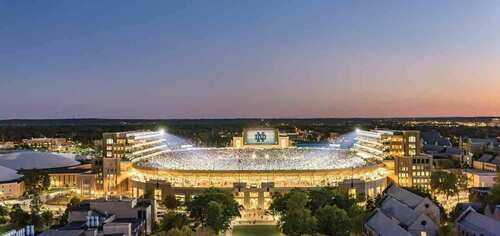
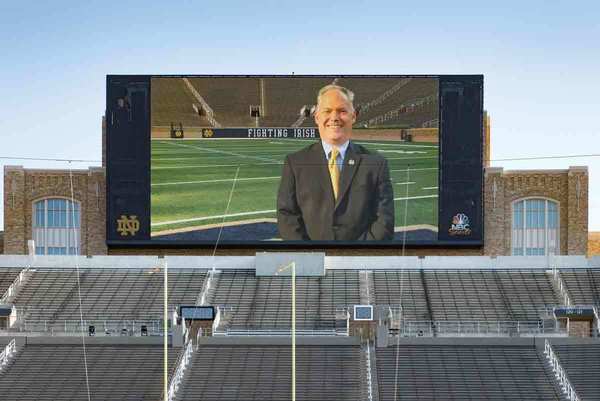 Mike Bonner
Mike Bonner
Mike Bonner, executive producer of live events for Fighting Irish Media (FIM), has attracted a lot of attention since he joined the University in 2016 to manage the operation of Notre Dame Stadium’s new state-of-the-art video board (He worked at Yankee Stadium! He knew George Steinbrenner!).
Bonner spent 14 years working for the Yankees (including five World Series), three years with the Broncos (with two Super Bowl seasons) and six Olympic games, including the Rio Olympics.
He’s often referred to as “the video board guy” now that he’s taken on the job of managing the operation of Notre Dame Stadium’s new video board, a 54.1-foot-high by 95.5-foot-wide behemoth with a crystal-clear, 4,798,976 pixel-LED display — the highest-definition video board in college football.
But what Bonner really wants people to know is that he may be executive producer, but he’s part of a large team. “If we count everyone, we’re pushing 60 people,” he says.
His teams are stationed on the field and at three different locations in the stadium on game days.
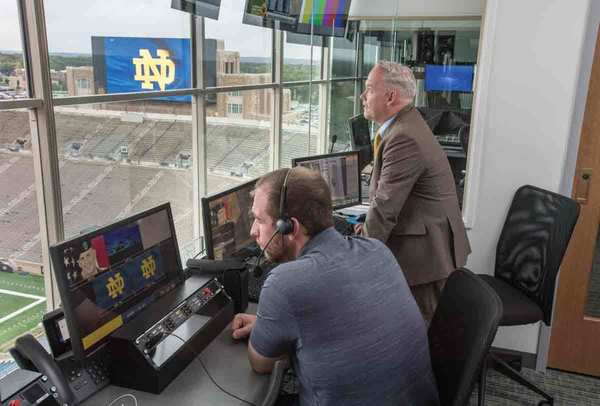 Mike Bonner (right) in the ninth floor video board control booth in Duncan Student Center.
Mike Bonner (right) in the ninth floor video board control booth in Duncan Student Center.
Bonner’s production booth is located on the ninth floor west side of Duncan Student Center, facing the field. The rest of the team works out two locations — the control room and replay room — of the state-of-the-art Rex and Alice A. Martin Media Center on the first floor of Corbett Family Hall. “Their view of the game is looking at camera feeds,” he says.
“Tony Simeone, the playback operator, is a jack of all trades. He also does on-camera work as the face and voice of our ‘Irish Scoreboard’ feature, giving updates on scores in other sports. Also up there I have the public address announcer (Mike Collins) a marketing assistant and his two spotters, an additional graphics person and the DJs (Craig Turney and Rodney Washington, who strictly play music. Others in the control booth on game day include playback producer Tony Simeone, the scoreboard operator and others who manage the game clock, the play clock, and down and distance. There’s also a separate ribbon board operator. The ribbon boards (393.07 feet wide by 3.78 feet high) on the east and west sides of the stadium run game-in-progress information at all times — the score, the time on clock, down and distance, possession and number of timeouts remaining.
“I also have August Kuehn (temp/on-call), who we call A-1, or Audio 1. He manages all other sounds that come through the PA system. That includes the PA announcer’s microphone, the referees’ microphones and the band microphones. All of our videos have sound, and A-1 is tracking those videos to make sure they’re not silent, and also tracks the music the DJ is playing — he’s on the fader and can bring the music up or down.”
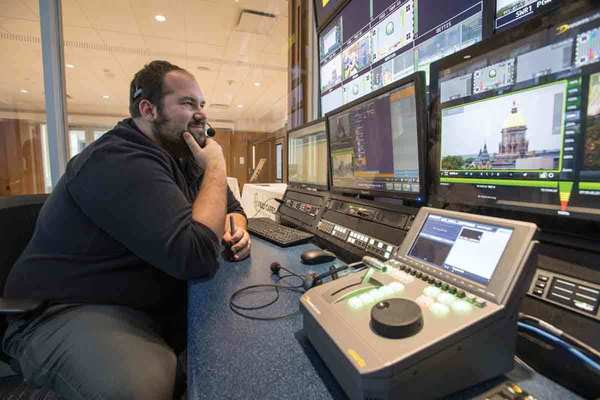 Nathan Bush, athletics digital media associate producer, in the main control room.
Nathan Bush, athletics digital media associate producer, in the main control room.
Game director Brock Raum, who works out of the Martin Media Center replay and acquisition room, “Is my right-hand man,” Bonner says. “He is the one I’m communicating with the most. He executes the replays and calls cameras.”
Also in the media center are replay producer Nathan Bush, social media moderator Reilly Fangman, four replay operators, two camera shaders (who adjust the camera settings for various light conditions) and a robotic camera operator. “We have 12 robotic cameras within the stadium, operated basically on a joystick.”
Each replay operator can bring in up to nine camera angles, he says, “So we can roll back replays of 36 different camera angles. That room is frenetic. Every play they are clipping off and lining up the highlights ready to go. If it’s a great highlight, they clip it off and add it to a playlist so later they can put together a package of several highlights in a row.” The replay room also supplies replays to the referees if they’re asked to take another look at another play, something that’s already resulted in multiple plays overturned on the field, many in favor of the Irish.
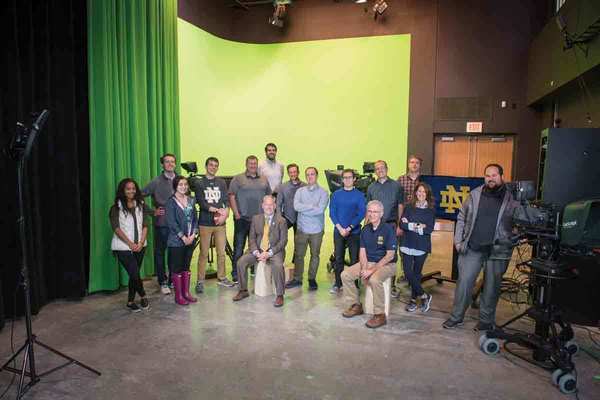 Mike Bonner, seated left, executive producer of live events, with some of the crew of nearly 60 full- and part-time University employees, student interns and freelancers necessary to handle the broadcast of home football games.
Mike Bonner, seated left, executive producer of live events, with some of the crew of nearly 60 full- and part-time University employees, student interns and freelancers necessary to handle the broadcast of home football games.
All those camera feeds are coming from another part of the team, the camera operators on the field (plus the feeds they take in from NBC.)
“We have nine manned cameras inside the stadium,” Bonner says. “Two are up high on the west side 35-yard-line: one at the north and one at the south. Those we call our game and tight-follow cameras. We also have two low end-zone cameras, on both the north and south ends of the stadium.”
Student workers Scott Hoyland and Natural Baptiste operate two wireless hand-held cameras can roam anywhere, inside or outside the stadium. Junior Micaela Powers operates the “slash,” a camera that shoots across the field toward the Notre Dame bench. NBC picked up some of her shots of the Georgia game, Bonner notes. Many of the other camera operators are freelance professionals (technically on-call/temporary staff).There are two hand-held wired cameras on the field. “They are tethered but can move anywhere from the 20-yard-line to the end zone at the north and south ends.” Each of those operators is assigned three student workers to make sure the cables stay plugged in and aren’t crossed with NBCs cables, and no one trips over them.
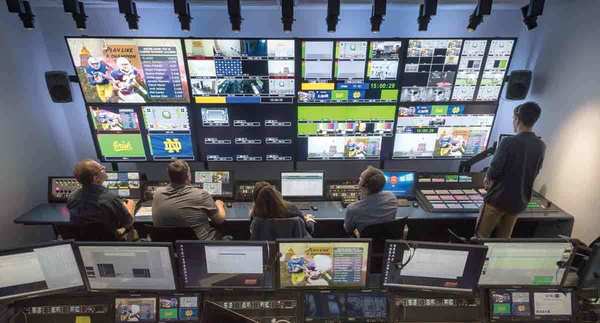 The Media Center main control room.
The Media Center main control room.
Bonner’s team can also take 12 camera feeds from NBC, and vice versa. Up high, NBC operates the 50-yard-line camera. “We take that because they have the virtual first-down marker and we can run that on the video board,” he says.
As executive producer, Bonner notes, “I run the show. But I rely on so many people. Our job is to entertain, engage and educate. Our job is to spread the University message, whether that’s a ‘What Would You Fight For’ feature or a great football video.”
Staff members
Executive Producer: Mike Bonner
Playback Producer: Tony Simeone
DJ: Craig Turney and Rodney Washington
A1: August Kuehn
Ribbon Board Stats: Student worker Juan Jose Rodriguez
Marketing: Jasmine Cannady; Janna Hughes; Darin Ottaviani; Brian Pracht; Becca Moore, Robert Judin and Khadijah Wiley
Stage manager: Kevin Barrett
PA Announcer: Mike Collins
Director: Brock Raum
Technical director: Rick Harman (temp/on-call)
Associate director: Jaye Galloway
Replay producer: Nathan Bush
Robotic camera operator: student worker Callee Stirn
Graphics 1: Kyle Miller ’07
Graphics Assist: John McDermott ’07, ’10 JD
Graphics 2: Student workers Regan Edwards and
Hunter Thompson
Social media moderator: Reilly Fangman
Replay operators: Joe Stachler; student worker Henry Davis; Chris Hagstrom-Jones (temp/on-call); and Jasmine Curry ’17 (FaithND intern)
Camera Shaders: Steve D’Ambrosia and David Gooding (both Temp/On-Call)
Postgame Show Producer: Josh Long (FaithND Producer)
Camera operators:
Full-time employees: Claude Devaney (ND Studios); Michael Wiens and Tony Fuller (Marketing Communications); Jon Cotton (Athletics Digital Media).
Temp/on-call: Bob Richthammer, Russ Hnatusko; Jon O’Sullivan and Gary Banks
Student workers: Scott Hoyland; Natural Baptiste; Micaela Powers; Emily Regan and Denise Dorotheo.
Grips: (all student workers): Mia Berry, Nick Taylor, Indi Jackson, Taylor Vucinich, Jack Kieffaber, Ana Urquijo, Dontae Knox, and Brian Haimes.